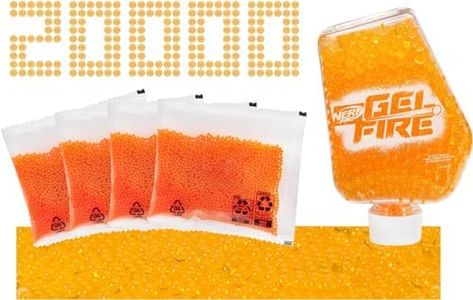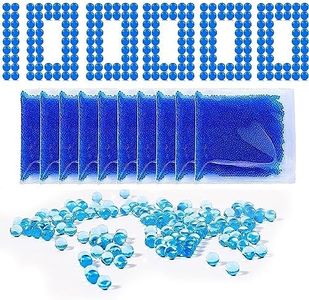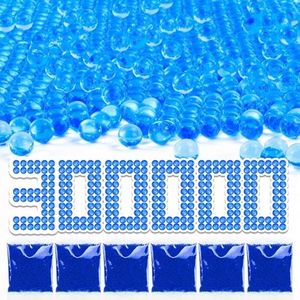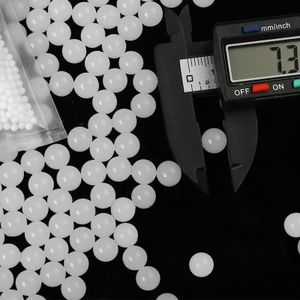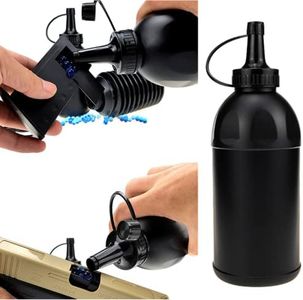We Use CookiesWe use cookies to enhance the security, performance,
functionality and for analytical and promotional activities. By continuing to browse this site you
are agreeing to our privacy policy
7 Best Gel Ball Blasters
From leading brands and best sellers available on the web.Buying Guide for the Best Gel Ball Blasters
When choosing a gel-ball blaster, it's important to match the product to your intended use, whether that's backyard fun, organized matches, or casual shooting. You'll want a blaster that's reliable and suits your experience level. Focusing on the main specifications will help you pick a model that fits your preferences for power, accuracy, ease of use, and maintenance. The right blaster should feel comfortable to hold, provide satisfying performance, and offer the right mix of features for your type of play. By understanding the key features, you can make a decision that ensures you have the most enjoyable and safe gel-ball blaster experience.Power/Velocity (FPS)Power, often listed as FPS (Feet Per Second), tells you how fast the gel balls shoot out of the blaster. Higher FPS means the balls travel faster and hit harder, which can affect accuracy and impact. Low FPS (under 120) is great for beginners or children since it's safer and gentler, while mid-range (120–180 FPS) offers balanced performance for casual and competitive play. High FPS (above 180) is best for advanced users who want maximum range and impact, usually in more regulated environments. To pick the right power level, consider who will use the blaster and where it will be used—higher FPS isn't always better if safety and comfort are priorities.
Magazine CapacityMagazine capacity refers to how many gel balls the blaster can hold before needing to be refilled. A small magazine (under 100 rounds) might require frequent reloads but is usually lighter and easier to handle. Medium capacity (100–250 rounds) offers a good balance for most users, keeping you in the action longer without becoming too bulky. Large capacity magazines (over 250 rounds) are great for extended play or group battles but can make the blaster heavier and harder to maneuver. Think about how often you want to reload and how long you plan to play at once—bigger isn’t always better if it affects comfort or handling.
Blaster Type (Manual vs. Automatic)Blaster type distinguishes between manual (spring-powered or single-shot) and automatic (battery or electric-powered) operation. Manual blasters are simple, require less maintenance, and are usually more affordable, but you have to prime them for each shot. Automatic blasters can fire multiple gel balls in quick succession by holding the trigger, making them more exciting and suited for fast-paced play. However, they require batteries and might need more care. If you enjoy a slower pace and more precision, manual is a good choice; for action-packed play or team games, automatic may offer a more thrilling experience.
Build Quality and MaterialsBuild quality and materials determine how tough or durable the blaster is. Blasters made from quality plastics tend to be lighter and affordable, suitable for kids and casual use. Higher-end models may use reinforced materials or metal parts, making them sturdier and longer-lasting, which is ideal for frequent players or rougher outdoor conditions. If you want a blaster for occasional backyard fun, standard plastic is fine. For regular or competitive play, choosing better materials means your blaster is less likely to break or wear down quickly.
Size and WeightSize and weight affect how comfortable and easy the gel-ball blaster is to use. Smaller, lighter blasters are easier to carry and maneuver, making them good for younger users or fast-moving play. Larger, heavier blasters might offer more features or power but can be harder to handle for long periods. Consider who will be using the blaster (kids, teens, adults) and how much mobility you want during play—lighter options are best for beginners, while heavier models can add realism and stability for experienced players.
Ease of MaintenanceEase of maintenance is all about how simple it is to clean and keep your blaster working properly. Simple designs with fewer parts are easier to take apart, clean, and reassemble, making them ideal if you want hassle-free ownership. More complex models might offer higher performance but require regular upkeep, such as lubrication and occasional part replacements. If you prefer a toy that just works with little effort, go for one with simple maintenance needs. Enthusiasts willing to spend more time can choose advanced models for better performance, knowing that extra care will be required.
